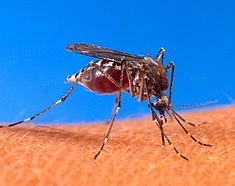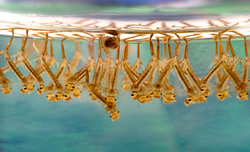
Back Muskiet Afrikaans Stechmücken ALS የወባ ትንኝ Amharic Culicidae AN بعوضيات Arabic ܒܩܐ ARC بعوضيات ARZ মহ Assamese Culicidae AST Sikimew ATJ
| Mosquito | |
|---|---|

| |
| Aedes aegypti: the vector of dengue fever and yellow fever | |
| Scientific classification | |
| Kingdom: | |
| Phylum: | |
| Class: | |
| Order: | |
| Suborder: | |
| Family: | |
| Subfamilies | |
| Diversity | |
| 43 genera | |

A mosquito is a type of fly. It is the common name of a family of flies in the order Diptera.
The females are ectoparasites: they land on warm-blooded animals, pierce a capillary, and inject saliva to stop the blood coagulating. Then they suck up and eat the blood. Deadly microscopic parasites often live in the saliva.[1][2] The mosquito's saliva is transferred to the host during the bite. It can cause an itchy rash. In addition, many species can transmit pathogens form one host to anoher, whien biting. In this way, mosquitoes are important vectors of parasitic diseases such as malaria and filariasis, and arboviral diseases such as yellow fever, Chikungunya, West Nile, dengue fever, and Zika. By transmitting diseases, mosquitoes cause the deaths of more people than any other animal taxon: over 700,000 each year.[3][4]
The males are nectar-feeders, and so are the females. However, in preparation for egg-laying the females turn to blood for its protein. [5]
- ↑ Harrison, Gordon A. 1978. Mosquitoes, malaria, and man: a history of the hostilities since 1880 ISBN 0525160256 / 0-525-16025-6
- ↑ Day, Nancy 2001. Malaria, West Nile, and other mosquito-borne diseases Enslow. ISBN 9780766015975
- ↑ "Mosquitoes of Michigan -Their Biology and Control". Michigan Mosquito Control Organization. 2013. Archived from the original on 2013-03-30.
- ↑ Bates C (2016-01-28). "Would it be wrong to eradicate mosquitoes? – BBC News". Archived from the original on 2016-02-01. Retrieved 2016-02-01.
- ↑ "Why do only female mosquitoes bite?". Mètode. 23 July 2015.
© MMXXIII Rich X Search. We shall prevail. All rights reserved. Rich X Search